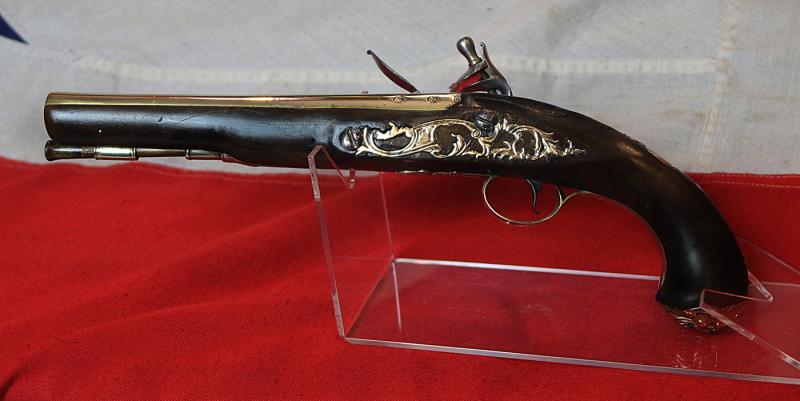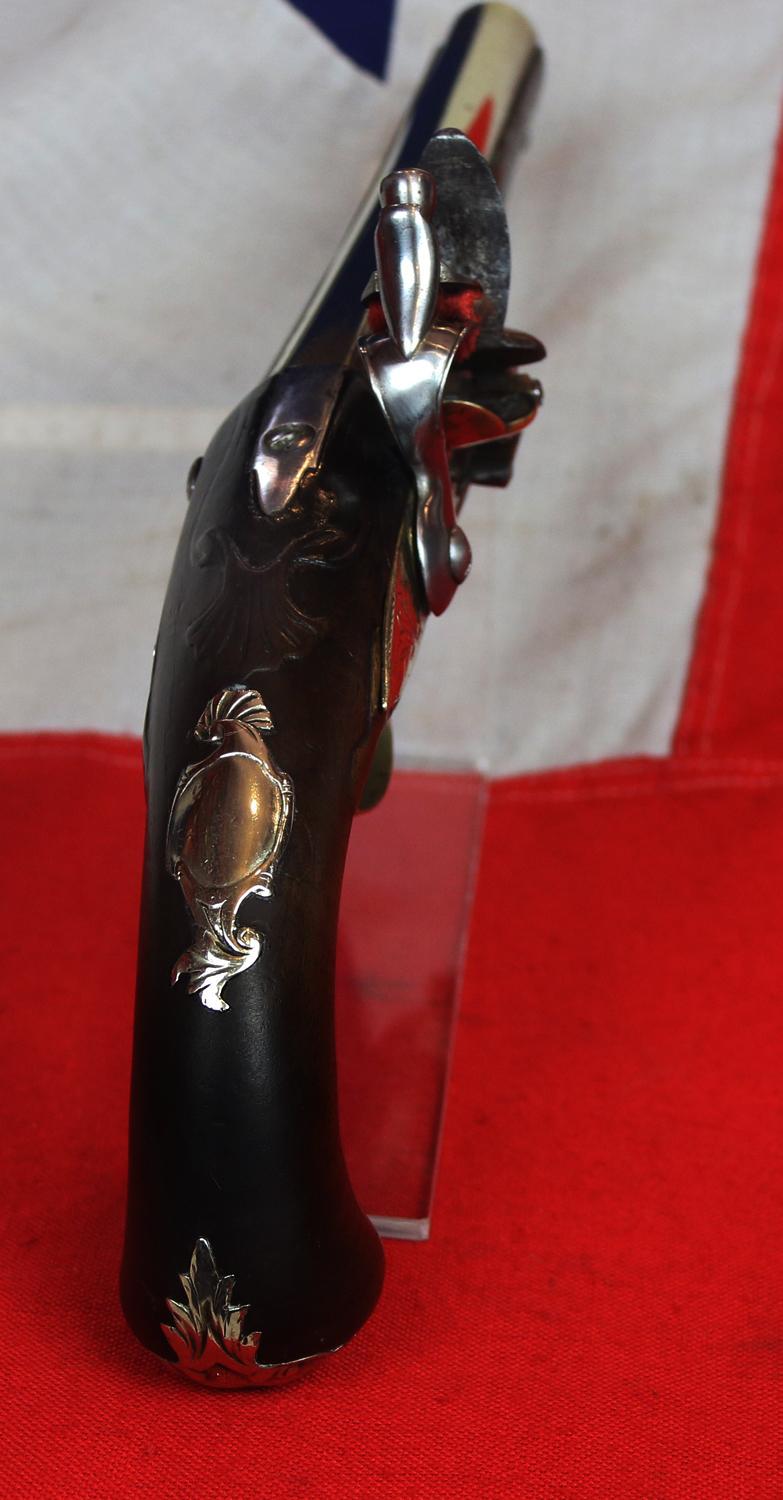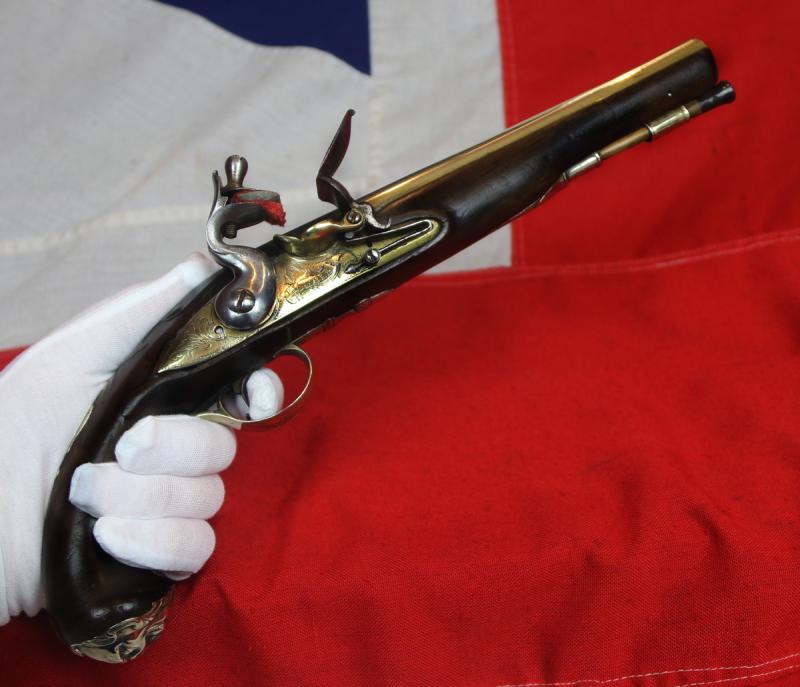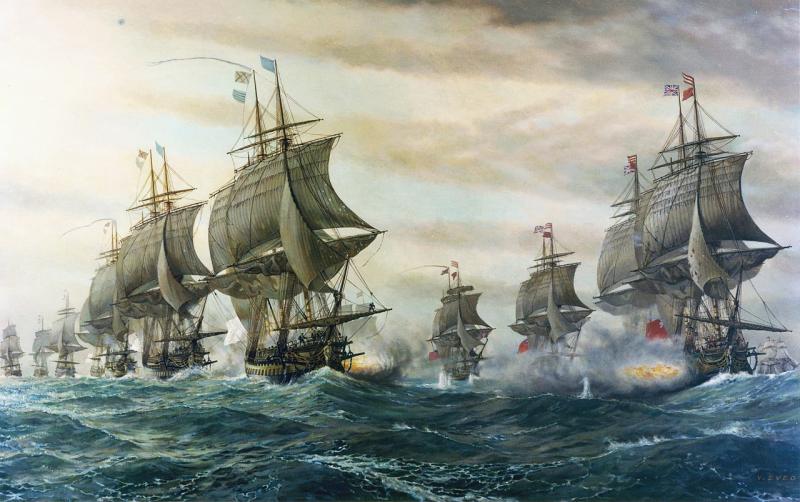A Fabulous 18th Century Brass Blunderbuss Barrelled Flintlock Royal Naval Captain's Pistol, c 1760, By Isaac Bissell a Renown Scottish Maker Of Leith & Birmingham, Who Also Traded in London
Made by isaac Bissell a maker from 1740 to 1780 who was a renown naval captain's pistol maker, supplier to the crown, and also similarly renown as a top maker of finest Scottish Highland officer's pistols, in the all metal Scottish fashion, with rams head butts. One of his surviving original, Scottish pistols is marked "RHR" on the barrel, standing for the Royal Highland Regiment (becoming the 42nd Royal Highland Regiment "Black Watch"), and many of the pistols carried by the men of the 42nd during the French and Indian War were actually made by Isaac Bissell.
This fine example was used by a British Naval Captain since the Anglo French wars in America, the American Revolution and right through the Napoleonic Wars. A good length pistol, with a typical, swamped, barrel, the octagonal breech having view and proof marks, with the barrel gently changing to round, and a very finely strawberry-leaf engraved brass rounded lock, signed by Isaac Bissell with unbridled frizzen and swan neck cock.
Superb ‘Jutland Regia’ walnut fullstock with bulbous butt; brass mounts and a tutaneg grotesque mask butt cap, rococco tutaneg escutcheon, a rococco, Romaneque pierced sideplate, and trigger guard with acorn finial; with horn tipped wooden ramrod. Very good condition brass cannon barrel .
These kind of all brass pistols were the weapon of choice for naval officers and ship's captains in the 18th century for use at sea. This is a superb example. The muzzle (and often the bore) was flared with the intent not only to increase the spread of the shot, but also to funnel powder and shot into the weapon, making it easier to reload in haste. The flared swamped muzzle is one of the defining features of this fabulous pistol. Ship's Captain's found such impressive guns so desirable as they had two prime functions to clear the decks with one shot, and the knowledge to an assailant that the pistol had the capability to achieve such a result. In the 18th and 19th century mutiny was a common fear for all commanders, and not a rare as one might imagine. The Capt. Could keep about his person or locked in his gun cabinet in his quarters a gun just as this. The barrel could be loaded with single ball or swan shot, ball twice as large as normal shot, that when discharged at close quarter could be devastating, and terrifyingly effective. Potentially taken out four or five assailants at once. The muzzle was swamped like a cannon for two reasons, the first for ease of rapid loading, the second for intimidation. There is a very persuasive psychological point to the size of this gun's muzzle, as any person or persons facing it could not fail to fear the consequences of it's discharge, and the act of surrender or retreat in the face of an well armed pistol such as this could be a happy and desirable result for all parties concerned.
Tutaneg was an exotic imported metal and popular in the 18th to the cusp of the 19th century. It was referred as such in 'Voyages and Descriptions by the great Capt. William Dampier. 1652-1715'. And in Daniel Defoe's book of 'The Adventures of Robert Drury'. It resembled silver but stronger like nickel, and was a metal used in England for small items of interest where silver was not practical. It's use died out in the 19th century. William Dampier was the first Englishman to explore parts of what is today Australia, and the first person to circumnavigate the world three times. He has also been described as Australia's first natural historian, as well as one of the most important British explorers of the period between Sir Walter Raleigh and James Cook. Traces of a small old contemporary fore-end wood repair
**Special Conservation Item
As with all our antique guns no license is required as they are all unrestricted antique collectables
Code: 24671










